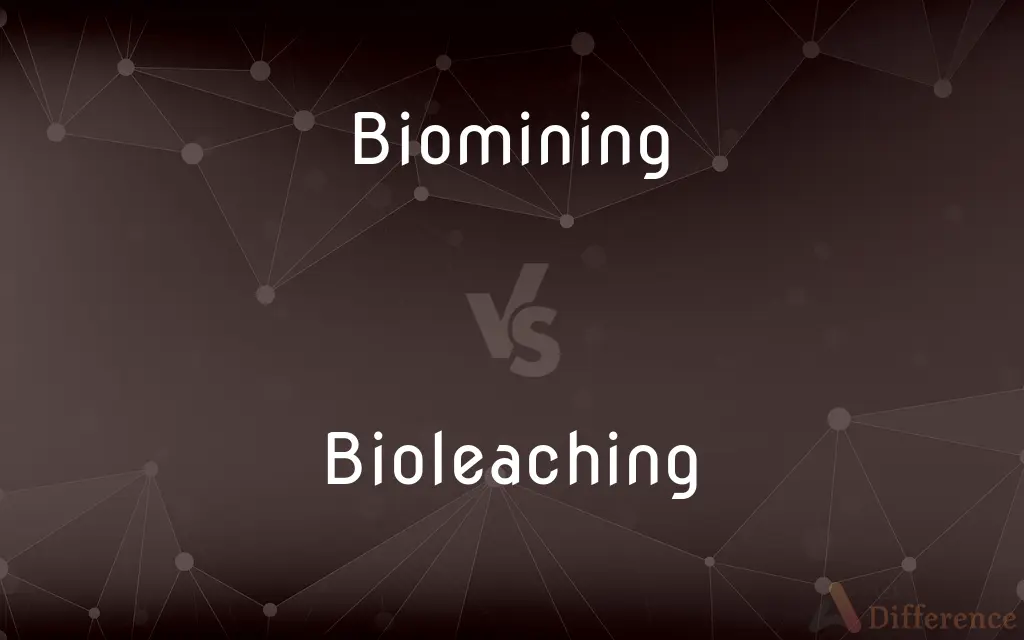Biomining vs. Bioleaching — What's the Difference?
By Tayyaba Rehman & Maham Liaqat — Updated on March 25, 2024
Biomining is the process of extracting valuable metals from ores using microorganisms, while bioleaching is a specific biomining technique where microbes leach metals from ores.

Difference Between Biomining and Bioleaching
Table of Contents
ADVERTISEMENT
Key Differences
Biomining encompasses various biotechnological processes, including bioleaching, for extracting metals like copper, gold, and uranium from ores using microorganisms. Bioleaching, on the other hand, specifically refers to the extraction process where bacteria or archaea dissolve metals, making them easier to recover.
While biomining serves as an overarching term for microbial metal extraction methods, bioleaching focuses on the leaching aspect, where microbes convert solid metal compounds in ores into soluble forms. Biomining techniques can include bioleaching but may also involve other processes like biooxidation.
Bioleaching is a critical step within the biomining process, especially for low-grade ores where traditional mining methods are not cost-effective. Biomining, as a broader term, can refer to the entire process from bioleaching to the final recovery of metals.
The microorganisms used in bioleaching, such as certain bacteria and archaea, thrive in extreme conditions and catalyze the breakdown of mineral ores, thereby releasing the metals. In the wider scope of biomining, these microbes might also be employed in pre-treatment stages like biooxidation, which prepares ores for further processing.
Bioleaching is often highlighted for its environmental benefits, such as reduced use of hazardous chemicals and lower energy requirements compared to conventional mining techniques. Biomining, encompassing bioleaching and other biotechnological methods, is considered an innovative and more sustainable approach to metal extraction, addressing both economic and environmental challenges in mining.
ADVERTISEMENT
Comparison Chart
Definition
Use of microorganisms to extract metals from ores
Microbial leaching of metals from ores
Scope
Broad term for microbial metal extraction methods
Specific process within biomining
Process
Includes bioleaching and other processes
Involves microbes converting metals into soluble forms
Application
For extracting various metals like copper, gold
Specifically for leaching metals
Microorganisms
Bacteria, archaea used for metal extraction
Specifically employed for leaching metals
Environmental Impact
Considered sustainable, with reduced chemical use
Noted for its environmental benefits
Compare with Definitions
Biomining
Encompasses various microbial methods for metal extraction.
Biomining applications are expanding beyond copper to include rare earth elements.
Bioleaching
A process where microorganisms leach metals from ores.
Bioleaching is particularly effective for low-grade ores that are not economically viable through conventional methods.
Biomining
The extraction of valuable metals from ores using biological means.
Biomining techniques have revolutionized the way we extract metals like gold and copper.
Bioleaching
Focuses on the leaching aspect of biomining.
The bioleaching process involves the use of bacteria to dissolve metal ions from ore.
Biomining
Offers a more environmentally friendly alternative to traditional mining.
Biomining reduces the environmental footprint of mining operations through microbial processes.
Bioleaching
Leverages the natural abilities of microbes to break down mineral ores.
Certain archaea used in bioleaching can withstand and thrive in highly acidic environments.
Biomining
Represents a cutting-edge approach in the mining sector.
Innovations in biomining are leading to more efficient and less invasive mining techniques.
Bioleaching
Facilitates the recovery of metals by converting them into a soluble form.
Copper bioleaching involves the solubilization of copper for easier extraction.
Biomining
Utilizes bacteria and archaea for metal extraction.
Specific strains of bacteria used in biomining accelerate the metal extraction process.
Bioleaching
Reduces the use of toxic chemicals in mining.
Bioleaching offers a greener alternative to cyanide in gold extraction.
Biomining
Biomining is the technique of extracting metals from ores and other solid materials typically using prokaryotes, fungi or plants (phytoextraction also known as phytomining or biomining). These organisms secrete different organic compounds that chelate metals from the environment and bring it back to the cell where they are typically used to coordinate electrons.
Bioleaching
Bioleaching is the extraction of metals from their ores through the use of living organisms. This is much cleaner than the traditional heap leaching using cyanide.
Biomining
The use of microorganisms to extract ions from ores
Bioleaching
The process of leaching metals from ore by using bacteria or fungi to convert the metals into a soluble form.
Bioleaching
The dissolution of metals from their ores by the use of microorganisms such as bacteria
Common Curiosities
Can bioleaching be used for all types of metals?
Bioleaching is most effective for certain metals like copper, gold, and uranium, especially in low-grade ores where traditional extraction methods are inefficient.
How do microorganisms extract metals in biomining?
In biomining, microorganisms catalyze chemical reactions that convert metal compounds into their soluble forms, facilitating metal extraction.
What are the environmental benefits of bioleaching?
Bioleaching offers environmental benefits such as reduced greenhouse gas emissions, lower energy consumption, and minimal use of toxic chemicals compared to traditional mining.
Is biomining cost-effective compared to conventional mining methods?
Biomining can be cost-effective, especially for low-grade ores that are not economically viable to process using traditional mining and extraction methods.
What is the main difference between biomining and bioleaching?
Biomining is a broader term that includes the use of microorganisms for metal extraction from ores, whereas bioleaching specifically refers to the microbial leaching process within biomining.
How does bioleaching contribute to sustainability in mining?
Bioleaching contributes to sustainability by offering a lower-impact alternative to conventional mining, using less energy and reducing the need for hazardous chemicals.
What challenges does biomining face?
Challenges include managing the bioleaching process to ensure efficiency, dealing with the byproducts of microbial activity, and scaling up operations for commercial viability.
What role do archaea play in bioleaching?
Certain archaea, adapted to extreme environments, play a crucial role in bioleaching by processing mineral ores in conditions where other microorganisms might not survive.
Can biomining be used to extract rare earth elements?
Research is ongoing into expanding biomining to extract rare earth elements, which are crucial for modern electronics and green technologies.
How is the metal recovered after the bioleaching process?
After bioleaching, metals in solution are recovered through processes such as precipitation, electrowinning, or solvent extraction, depending on the specific metal and operational considerations.
Share Your Discovery

Previous Comparison
Ahmedabad vs. Pune
Next Comparison
Structure vs. BuildingAuthor Spotlight
Written by
Tayyaba RehmanTayyaba Rehman is a distinguished writer, currently serving as a primary contributor to askdifference.com. As a researcher in semantics and etymology, Tayyaba's passion for the complexity of languages and their distinctions has found a perfect home on the platform. Tayyaba delves into the intricacies of language, distinguishing between commonly confused words and phrases, thereby providing clarity for readers worldwide.
Co-written by
Maham Liaqat















































